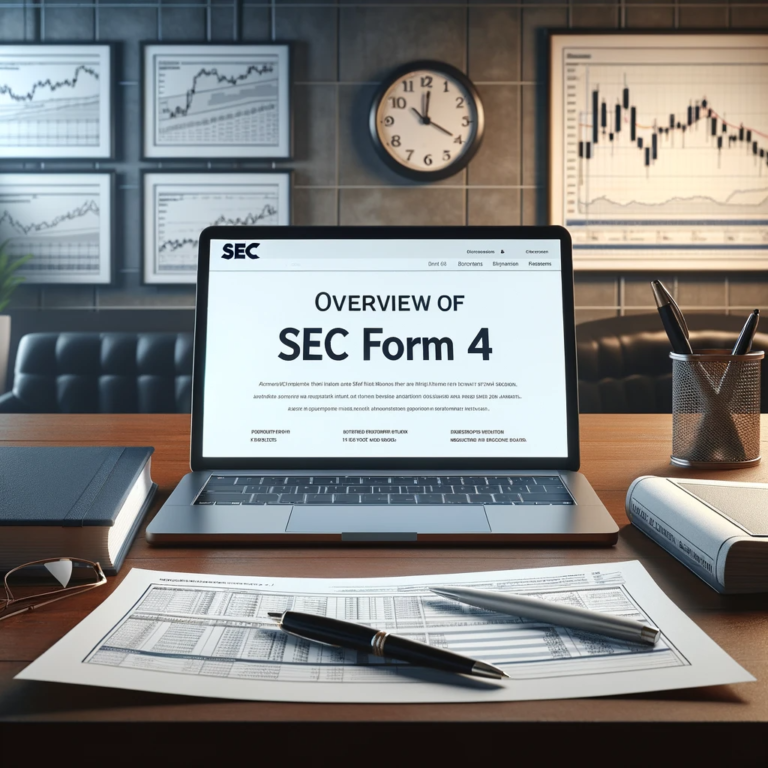Reading SEC Form 4
Reading SEC Form 4: Navigating Insider Transactions and Market Insights (150 Words)
Reading SEC Form 4 – The SEC Form 4 is an essential document for any investor keen on understanding the inner workings of the companies they are invested in. It provides a window into insider transactions that could signal crucial shifts in stock prices or company health. Grasping the subtleties of these filings is key to making informed decisions in the market.
Navigating the intricate landscape of insider transactions offers investors a unique vantage point into the confidence company executives and major shareholders have in their own firms. By carefully scrutinizing SEC Form 4 filings, astute investors gain access to market insights that are hidden in plain sight.
These disclosures allow investors to observe the buying and selling activities of insiders, which can serve as a barometer for a company’s financial health and future prospects. Parsing through Form 4 documents reveals much more than mere numbers; it unveils patterns and trends of investment decisions made by those with the most intimate knowledge of the company’s inner workings.
Consequently, mastering how to read these filings equips investors with an invaluable tool, enhancing their ability to make well-informed decisions that are aligned with the sophisticated understanding of market dynamics and the strategic moves of insiders.
Reading SEC Form 4: Unveiling SEC Form 4 – An Essential Regulatory Document
SEC Form 4 stands at the heart of regulatory compliance, serving as a declaration of beneficial ownership and informing the public of insiders’ trades. Understanding its implications is foundational to comprehending the complexities of insider trading within the legal framework.
Comprehending the critical elements of SEC Form 4 is paramount for investors who strive to delve deeper into the dynamics of financial markets. This regulatory filing is mandated by the U.S. Securities and Exchange Commission (SEC) to promote transparency and maintain fair trading practices. It is an official document that insiders of publicly traded companies—such as officers, directors, and large shareholders—must file within two business days of executing a transaction involving company stock.
SEC Form 4 serves as a cornerstone in the regulatory structure designed to prevent illegal insider trading. It provides a clear glimpse into the buying, selling, and option exercises of company insiders, offering insights that can help gauge the sentiment of those most knowledgeable about the company’s future. Through this lens, investors can discern whether insiders are bullish, accumulating more shares, or bearish, offloading their holdings.
The insights garnered from these filings are invaluable as they not only signify compliance with federal securities laws but also reflect the insiders’ confidence in the management and trajectory of their companies. Investors equipped with the knowledge of interpreting Form 4 can elevate their understanding of corporate governance and insider behavior—information that, when analyzed correctly, can lead to more informed and strategic investment decisions.
Reading SEC Form 4: Insider Transactions Exposed: Making Sense of the Data
Transactions committed by company insiders can be a telling indicator of a company’s direction. By decoding the transaction codes and observing patterns of insider buying or selling, one can gauge the confidence levels of those at the helm.
In the realm of stock market investing, the adage “knowledge is power” holds particularly true when it comes to deciphering insider transactions. SEC Form 4 is a treasure trove of data that, when interpreted astutely, can yield actionable insights for investors. It is the document insiders must file to report their trades, granting the public access to real-time information on insider activities.
Insiders—executives, directors, and beneficial owners—are privy to nonpublic information that can have a profound impact on their company’s stock price. Although insider trading regulations are in place to prevent misuse of such information, legal trades made by insiders can offer clues about the company’s financial health and potential future performance.
Transaction codes are the keys to unlocking the story behind each trade. For example, a Code “P” indicates a purchase, a sign that an insider is bullish enough to use personal funds to acquire shares, often inspiring confidence among investors. Conversely, a Code “S” denotes a sale, which might be interpreted as a lack of confidence, although it could just as well be part of a planned diversification or a liquidity event. Furthermore, an “M” code signals the exercise of stock options, a transaction that warrants closer examination to determine the underlying incentive or strategy.
Beyond the codes, the timing and volume of insider transactions are equally revealing. Significant buying activity post-earnings, for instance, might suggest that insiders perceive the stock to be undervalued, while a flurry of selling could indicate impending challenges.
The data on SEC Form 4 also includes direct and indirect ownership, offering insights into how insiders are positioning themselves in relation to the company. Direct ownership signifies a more straightforward economic interest, while indirect ownership, through trusts or family members, may require more nuanced analysis.
In essence, SEC Form 4 enables investors to peek over the shoulders of insiders. By doing so, one can make educated guesses about the future direction of a company, based on the actions of those who likely know it best. Investing is not just about analyzing the numbers on financial statements; it’s also about reading between the lines of insider transactions to understand the broader narrative.
Reading SEC Form 4: Deciphering SEC Form 4: A Step-By-Step Guide
Interpreting the nuances of SEC Form 4 can be likened to a financial detective piecing together clues to unveil the investment narrative of insiders. This guide aims to demystify the process, allowing you to confidently navigate the form’s complexities.
Understanding the Structure of SEC Form 4
Familiarize yourself with the form’s layout, beginning with the header section that lists the registrant’s name, followed by tables detailing the transactions.
Registrant Information and Reporting Ownership
Examine the identifying information of the insider, including name and title, and determine whether the ownership is direct or indirect, which has implications for control and influence over the securities.

Analyzing the Table of Transactions
Transaction Date and Reporting Codes
Identify the date on which the transaction took place and learn the meanings of various SEC transaction codes, which describe the type and nature of the transaction.
Transaction Amounts and Price
Understand how to read the shares traded, the price point for those shares, and any patterns that emerge from these trades.
Post-Transaction Ownership Details
Review the cumulative ownership of securities following the transaction, as this can reflect an insider’s commitment or divestment in the firm.
Identifying Different Types of Securities
Distinguish between the forms of equity, such as common stock or derivatives like options, to fully comprehend the filing’s implications for the company and its stock.
Special Attention to Remarks Section
Pay heed to any additional information provided by insiders in the remarks section, which can contain vital contextual details or explanations for the transactions listed.
Reading SEC Form 4: Leveraging Insider Information for Strategic Investment
Insider trading activity captured in Form 4 filings can be incorporated into investment strategies, offering insights into potential bullish or bearish market sentiment.
Astute investors understand that information is the lifeblood of strategic investment decision-making. SEC Form 4 is a repository of such vital information, revealing the trading activities of company insiders. These transactions, while publicly disclosed and entirely legal, offer foresight into the sentiment of those with the most intimate knowledge of a company’s inner workings.
The savvy investor uses this information as part of their due diligence process to assess the stock’s potential. For instance, a cluster of insider purchases may signal that executives are confident about upcoming prospects, possibly foreshadowing positive developments that could boost share prices. Conversely, a pattern of insider selling could raise caution flags, prompting investors to dig deeper into potential issues or changes in overall company valuation.
Understanding the subtleties of insider transactions goes beyond simply monitoring volume and timing. It involves discerning the intent behind these trades. Are insiders acting on the basis of a 10b5-1 trading plan, set up to systematically sell or purchase shares? Or are these ad-hoc transactions spurred by current market conditions or upcoming events?
Incorporating insider trading data into an investment strategy isn’t about mimicking insider moves; rather, it’s about context. The investment landscape is complex, and no single indicator is foolproof. However, when combined with other research, the insights from SEC Form 4 can enable investors to fine-tune their strategies. Perhaps they’ll leverage information on insider trades when considering the timing of their investments or align their positions with those who should, theoretically, know best.
In conclusion, while insider trading data offers a narrow view of market dynamics, its strategic application can complement broader analysis, laying the groundwork for informed and opportunistic investment choices.
Reading SEC Form 4: Retrieving and Reviewing SEC Form 4: A User’s Guide
Navigating the EDGAR system to access SEC Form 4 documents is crucial for timely and informed investment decisions, underscored by an understanding of the SEC’s review process.
In the digital age of finance, gaining access to insider transaction records is streamlined thanks to the SEC’s EDGAR (Electronic Data Gathering, Analysis, and Retrieval) system. Understanding how to retrieve and review SEC Form 4 is fundamental for conducting thorough due diligence and remaining abreast of significant company developments.
Accessing SEC Form 4 through EDGAR
Firstly, navigate to the EDGAR database on the SEC’s website. Using the search functionality, you can locate a company’s Form 4 filings by inputting either the company name or its unique CIK number. These filings are freely accessible to the public and are typically available within two business days of the insider transaction date, ensuring timely insights into insider activities.
Analyzing the Form 4 Filing
Upon accessing the document, systematically review each part. Start with the reporting owner’s details to confirm the role and affiliation with the company. Understanding who is buying or selling provides context; transactions by high-ranking executives or board members might carry more weight in your analysis.
Next, delve into the specifics of each transaction, noting the type, quantity, and price of securities involved. The Reporting Persons Information section will disclose any changes in ownership stakes.
Navigating the Filing and Review Process
Form 4 filings are subject to the SEC’s review, an aspect that underscores the importance of the integrity and accuracy of these documents. Recognizing the SEC’s regulatory oversight can give investors additional confidence when interpreting disclosed information.
In sum, retrieving and reviewing SEC Form 4 is a straightforward yet powerful process. With this guide, investors can take advantage of the wealth of information provided and transform data extraction into actionable intelligence.
Reading SEC Form 4: Market Impact: Insider Filings’ Effect on Stock Price
Correlate patterns in insider trading reports with stock price movements to evaluate how actions by insiders are perceived in the broader market.
The revelation of insider transactions through SEC Form 4 filings can act as a catalyst in the stock market, often precipitating notable price movements. This comes from the market’s perception of insider trades as informed actions, as insiders typically possess an in-depth understanding of their companies’ operational health and strategic direction.
When insiders buy shares, it can signal to the market a strong belief in the company’s future prosperity, potentially underpriced stock, or knowledge of positive developments yet to be publicly disclosed. These actions may lead to increased investor confidence and a subsequent rise in share prices, as market participants interpret insider buying as an optimistic indicator.
Conversely, if insiders are selling their shares, it might raise concerns among investors regarding the company’s forthcoming performance or its current overvaluation, which could result in a dip in the stock price. However, such interpretations require careful consideration of context—insider selling isn’t necessarily a sign of bleak prospects; it may also reflect portfolio diversification or personal financial planning.
Moreover, the volume and timing of transactions, disclosed on Form 4, present another layer for analysis. A single insider’s trade might not sway the market significantly, but concerted buying or selling by multiple insiders could be seen as a more definitive sentiment about the company’s trajectory.
In essence, the stock market often reacts to the insights SEC Form 4 filings offer, making them a valuable component for investors gauging the impact of insider behaviors on share prices.
Reading SEC Form 4: SEC Form 4 During Organizational Change
In times of great corporate change, such as mergers or management shifts, SEC Form 4 filings can shed light on insider perspectives and strategies.
As organizations navigate through periods of significant transitions like mergers, acquisitions, or leadership changes, SEC Form 4 filings unveil insider perspectives during these pivotal moments. Insider transactions during such times are particularly scrutinized for clues about the future direction and stability of the company.
Amidst organizational restructuring or strategic shifts, insiders—those with the most intimate knowledge of internal affairs—may adjust their holdings in response to the impending changes. An influx of insider buying could be interpreted as a strong endorsement of the forthcoming strategy or a merger’s anticipated synergistic benefits. On the other hand, substantial selling may raise questions about the perceived value or success of the new path the company is charting.
In some cases, a related filing, Form S-4, is used to register securities for exchange offers or mergers, providing additional information on corporate actions. Watching for Form 4 filings in conjunction with Form S-4 can yield a comprehensive view of insider sentiment during these corporate maneuvers.
The transactions captured in SEC Form 4 in such scenarios offer a candid disclosure of the convictions and concerns insiders may have about the company’s long-term prospects. Investors should pay close attention to these filings as they can highlight insider confidence or caution, thus informing shareholders about potential outcomes of the changes underway.
Reading SEC Form 4: The Fine Print: Interpreting the Subtleties of SEC Form 4
Avoiding misconceptions requires a nuanced understanding of SEC Form 4. Recognizing the distinctions between legitimate and questionable transactions keeps investors informed.
Mastering the art of reading between the lines of SEC Form 4 can uncover a wealth of subtleties often overlooked by the casual observer. These finer details can provide a more nuanced understanding of insider activities and the implications for the company.
For example, the frequent use of planned selling arrangements, known as 10b5-1 plans, indicates pre-scheduled trading activity, often misconstrued as spontaneous insider sentiment. Discerning investors recognize that these programmed transactions do not always correlate with insider confidence levels and should be interpreted accordingly.
Further investigative rigor should be applied to the transaction’s context, such as historical trading patterns or concurrent company developments. An insider may sell immediately after stock options vest, not necessarily indicating a bearish outlook, but rather a routine exercise of compensation.
Likewise, the quantity of shares traded relative to the insider’s total holdings presents another layer of insight. Minor changes in ownership may not signify changes in conviction, while significant proportion alterations could be more telling.
Lastly, attention ought to be paid to the remarks section. Occasionally, it contains pivotal clues that can either reinforce the narrative suggested by the raw data or present an entirely new dimension—be it an insider’s forthcoming retirement or compliance with a divorce decree.
In essence, SEC Form 4 holds much more than meets the eye. Scrutinizing its fine print is an invaluable exercise for those aiming to gauge the true sentiment behind insider trades.
Reading SEC Form 4: Complexities of SEC Form 4 in the Modern Financial Ecosystem
Contemporary challenges, including the interplay of digital assets in SEC regulations, demand a sophisticated approach to interpreting financial disclosures.
The financial ecosystem is evolving rapidly, and with it, the complexities surrounding SEC Form 4 have grown. In this modern landscape, the influx of digital assets, such as cryptocurrencies and their derivatives, introduces new considerations for investors interpreting these crucial filings.
Insiders of companies that engage in blockchain technology or hold digital assets may report transactions that don’t fit neatly into traditional equity structures. This necessitates a refined understanding of how digital asset transactions are reported and the implications they may have on a company’s financial standing and stock price.
Moreover, the integration of international markets and the burgeoning presence of global investors challenge the interpretation scope of SEC Form 4. Transactions by insiders who are subject to different regulatory environments or who might be buying and selling in markets across various jurisdictions add layers to the already intricate puzzle.
Furthermore, the practice of using equity awards as a significant part of compensation packages for executives has increased the frequency and complexity of transactions reported on Form 4. Each award type, whether it’s restricted stock units, stock options, or performance shares, carries its own set of rules for reporting and disposal, thus requiring investors to be alert to the subtleties of these varied instruments.
In the face of these complexities, investors must continuously adapt their analytical approaches to SEC Form 4. Doing so ensures that they maintain a comprehensive understanding of insider transactions in an ever-changing financial world.
Reading SEC Form 4: Using SEC Form 4 as an Educational and Research Instrument
Beyond investment decisions, Form 4 serves as a valuable tool for educating emerging investors and conducting thorough financial analyses.
The insightfulness of SEC Form 4 extends beyond the realms of investment decision-making to serve as a potent educational and research instrument. For finance students and professionals alike, it operates as a live case study, illustrating the practical applications of securities law and corporate governance.
Academic institutions can incorporate Form 4 analysis into their curricula to teach students how to dissect real-world insider transactions. As students track the buying and selling patterns of company directors and officers, they learn to identify market signals and the potential motivations behind insider behaviors. This hands-on experience with financial documents equips next-generation investors with the skills necessary for nuanced investment analysis.
In research contexts, SEC Form 4 is a valuable data source for studies exploring the correlation between insider trading patterns and various market phenomena. Researchers rely on these filings to build empirical models that test theories on market efficiency, corporate transparency, and the informational value of insider trades.
Moreover, aggregating data from Form 4 filings can yield insights into broader economic trends and the health of different sectors. It helps analysts decipher macro-level patterns and understand the market dynamics at play.
Thus, SEC Form 4 is not just a formality of compliance but a ripe resource for educational enrichment and research profundity, promoting a deeper comprehension of the financial markets’ intricacies among learners and experts.
Reading SEC Form 4: Key Takeaways
- Demystifying the Document: SEC Form 4 is crucial for tracking insider transactions, revealing the buying and selling activities of company insiders.
- Decoding Insider Sentiment: Transaction codes within Form 4 provide insights into insider confidence, with patterns in buying or selling offering potential market signals.
- Navigating the Data: Accessing and understanding Form 4 filings is straightforward through the SEC’s EDGAR system, where timely information can be sourced for strategic decision-making.
- Market Influence: Insider trading disclosures have the potential to impact stock prices, with significant insider buying often viewed as confident and bullish, and selling seen as potentially bearish.
- Corporate Change Indicators: Transactions during periods of organizational change can signal insider perspectives on the value and expected outcomes of these changes.
- Understanding Context: Analyzing the subtleties and context within SEC Form 4 filings is essential to fully grasp the motivations behind insider trades.
- Adapting to Modern Challenges: The complexity of Form 4 has grown with the financial ecosystem’s evolution, requiring investors to be abreast of interpreting digital assets and complex compensation structures.
- Educational Resource: SEC Form 4 serves as a practical educational tool for finance students and a rich data source for academic research, promoting a deeper understanding of market behaviors.
- Strategy Enhancement: Harnessing the information within SEC Form 4 can elevate an investor’s approach, providing a competitive edge in the market landscape.
Reading SEC Form 4: The Insider’s Advantage – Harnessing the Power of SEC Form 4 (50 Words)
Mastering the intricacies of SEC Form 4 empowers investors with a strategic edge, illuminating the path to confident and educated investment choices in an ever-evolving marketplace.
Utilizing the insights from SEC Form 4 endows investors with an insider’s advantage, allowing for a profound understanding of company sentiments. By mastering the interpretation of these filings, investors can align their strategies with the knowledgeable moves of insiders, turning regulatory disclosures into valuable investment foresight.







